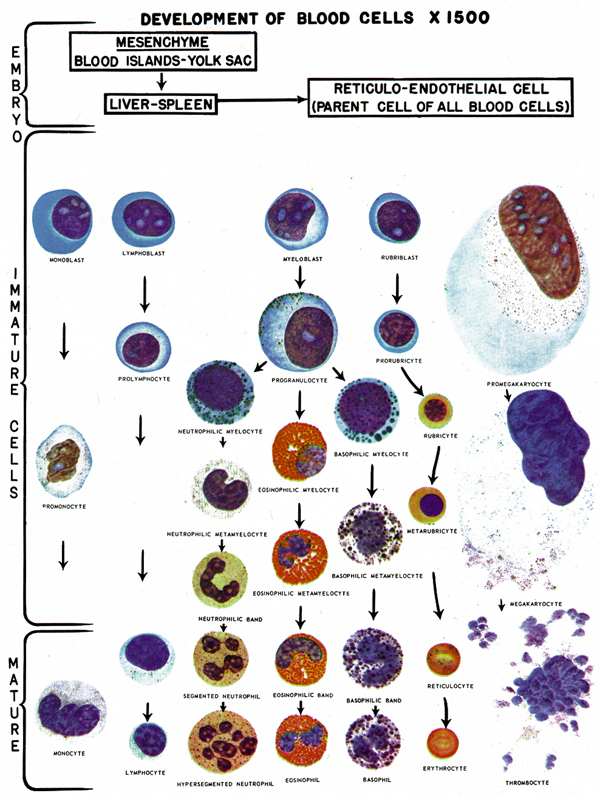Peripheral Smear
| A microscopic examination of a
stained, peripheral blood smear may be useful in evaluating blood
disorders.
Anisocytosis
- These are abnormal in size
Basophilic Stippling
- Usually seen in reticulocytes, an immature form of RBC, released in
response to strong stimulus, and seen in:
- Is nearly universally seen in cases of clinically significant lead
poisoning.
Hypochromic
- The normally pale center of the RBC is even more pale, suggesting
reduced concentrations of hemoglobin within the cell.
Malarial Stippling
- Very fine granular appearance to the RBCs, representing malarial
parasites.
- Also known as:
- Schueffner's dots
- Parasitized RBCs
Normochromic
- Normal amounts of staining for hemoglobin, suggesting normal
concentrations of hemoglobin within the cell.
Nucleated RBCs
- In an adult, RBCs are not normally nucleated.
- The presence of NRBCs indicates the body is aggressively producing
red cells and releasing them into the circulation prior to full
maturity.
- This is commonly seen in cases of significant anemia.
Poikilocytosis
- These are abnormal in shape.
- This due to improper formation of the cell membrane.
- This typically occurs in cases of severe anemia when the RBC
manufacturing system goes into overdrive, greatly increasing the
number of RBCs produced, but with lesser degrees of quality control.
Polychromasia
- Variations in staining of the RBC suggesting a more rapid production
than is usually seen.
- Commonly seen in anemias of all types, but particularly hemolytic
anemias and anemias following acute blood loss.
Reticulocytes
- An immature form of RBC, it released in
response to strong stimulus, and seen in:
Shistocytes
- Bizarre-shaped RBCs, resembling triangles or spirals.
- Associated with:
- Severe burns
- DIC
- Artificial heart valves
- Vascular spasm
Sickle Cells
- Crescent-shaped RBCs, associated with abnormal hemoglobin formation
(Hemoglobin S, SS, SC, SD or Sickle-Thallasemia.)
- Associated with hemolytic anemia.
Spherocytes
- Smaller and rounder than normal RBCs
- Associated with:
- Hereditary disease
- Post-transfusion changes
- Water dilution
Target Cells
- Smaller than normal RBCs, with a central concentration of
hemoglobin, giving it the appearance of a target.
- Associated with:
- Liver disease
- Iron deficiency anemia
- Thallesemia
|
Normal Values of the Peripheral Smear*
| Size |
Normocytic (7-8 µm) |
| Color |
Normochromic |
| Shape |
Normocyte |
| Structure |
No nucleated cells |
*These are general values taken from a variety of
sources. The actual normal values may vary from lab to lab and from one
type of testing protocol to another.

Development of Blood Cells |
|
|
Approved for public release;
Distribution is unlimited.
The listing of any non-Federal product in this CD is not an endorsement of the
product itself, but simply an acknowledgement of the source.
Bureau of Medicine and Surgery
Department of the Navy
2300 E Street NW
Washington, D.C
20372-5300 |
Operational Medicine
Health Care in Military Settings
CAPT Michael John Hughey, MC, USNR
NAVMED P-5139
January 1, 2001 |
United States Special Operations
Command
7701 Tampa Point Blvd.
MacDill AFB, Florida
33621-5323 |
*This web version is provided by
The Brookside Associates Medical Education Division. It contains
original contents from the official US Navy NAVMED P-5139, but has been
reformatted for web access and includes advertising and links that were not
present in the original version. This web version has not been approved by the
Department of the Navy or the Department of Defense. The presence of any
advertising on these pages does not constitute an endorsement of that product or
service by either the US Department of Defense or the Brookside Associates. The
Brookside Associates is a private organization, not affiliated with the United
States Department of Defense.
Contact Us · · Other
Brookside Products

|
|
Operational Medicine 2001
Contents
|
|


